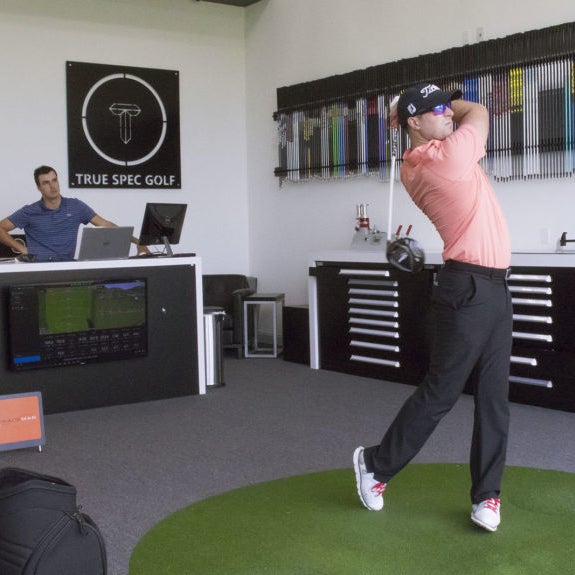Kris McCormack
A proper club-fitter will take club length into account.
True Spec Golf
Let’s talk about club length. You’ve probably heard something like “measure your wrist to the floor and call it a day.” Maybe you even Googled a chart, measured yourself in the mirror, and thought, Yep, I need half an inch over standard. Quick and easy, right?
Not quite.
First off, let’s clear this up: there’s no such thing as a true “standard” length. One company’s standard 7-iron might be half an inch longer than another’s. That’s why basing your specs off a chart, or assuming the clubs you’ve always played are correct, can get you into trouble. The truth is, fitting for club length is way more nuanced than that.
Why a properly fit shaft can help your game more than you might realize
By:
Kris McCormack
So, if you’re serious about dialing in your gear, you’ll want to dig deeper. Let’s unpack why getting fit properly matters, and why “standard length” might not be YOUR standard.
There’s no universal standard for club length
Before we even get into how your body affects your ideal specs, let’s address something most golfers don’t realize: club length isn’t standardized across the industry.
Seriously. What’s considered “standard” for a Titleist 6-iron might be longer than a Mizuno, shorter than a Ping, and totally different from what Cobra or Callaway calls standard. Some brands build with longer shafts across the board. Others vary by club line; “Game Improvement” irons often come a touch longer than “Players” irons to squeeze out a little extra distance.
So, if you were fit into “standard length” with one brand, and then just order another brand off the rack thinking it’ll match up… well, good luck. You might be swinging something totally different without even knowing it.
This is also why that wrist-to-floor measurement (and those online calculators) can be a bit misleading. They’re referencing a generic chart… usually based on one brand’s version of “standard” … which may or may not match what you’re actually swinging.
Moral of the story: Don’t chase a number. Chase a fit.
It’s not how tall you are—It’s how YOU are tall
One of the biggest misconceptions in golf is that taller people automatically need longer clubs, and shorter people need shorter ones. But height alone doesn’t tell the full story. What really matters is your body proportions and how you move the club.
You could be any of the following:
- Short with long arms and a low posture… hello, standard length or even a smidge under.
- Tall with T-Rex arms and an upright setup… maybe you do need longer sticks.
- NBA proportions: towering heigh with a 7ft wingspan… enjoy playing the same length as me at 5’10.
- Average height with freakishly long legs and a short torso… good luck finding a chart that covers that. (plot twist, that’s my build)
Why obsessing only over ball speed can actually cost you distance
By:
Kris McCormack
This is where the classic “wrist to floor” method starts to fall apart. It ignores your setup, posture, flexibility, swing plane, and tempo. All the things that actually influence how you deliver the club to the ball. So yeah, you can use that measurement as a baseline, but it’s far from an exact science.
The real variables that matter
When you go through a proper fitting, the fitter isn’t just pulling out a measuring tape and calling it a day. They’re looking at several key elements, including:
Posture at address: Do you stand upright or bend deep from the hips?
Arm length: Longer arms mean you might be more comfortable with shorter clubs, even if you’re tall.
Swing style: Do you play with a flat swing or are you more upright? Club length can influence your swing plane.
Attack angle and consistency: Are you finding the center of the face, or are you living on the toe or heel?
Lie angle: Length and lie are tied at the hip. If you change one, the other usually needs adjusting too.
Clubhead speed and control: Sometimes going shorter gives you more control. Longer might add speed — but at what cost?
A good fitter will test multiple lengths, check your impact locations, look at your dispersion, dial in your start direction, and adjust from there. The goal isn’t to fit you to a chart, it’s to fit the club to your unique swing DNA as a golfer.
All of our market picks are independently selected and curated by the editorial team.
If you buy a linked product,
GOLF.COM may earn a fee. Pricing may vary.

True Spec Club-Fitting
Ready to improve your game this season? Book a fitting with True Spec experts now.
Don’t let your ego choose your specs
We get it. No one wants to hear they might need shorter clubs. But if that’s what helps you flush it more often, what’s the problem? Length isn’t a badge of honor, it’s a tool. And like any tool, it works best when it’s the right size for the job.
Tour players get this. Plenty of pros play shorter-than-standard irons because it helps them control flight and find the center of the face more consistently. If they’re not chasing distance with longer shafts, why should you?
So, what should you do?
Get fit. Period.
No, I’m not talking about just a quick once-over at the big box store. That’s not a true fitting. Find a fitter who understands how all the pieces; length, lie, weight, flex, and dynamic balance interact. Someone who watches your swing, asks questions, makes adjustments, and helps you find the best version of your equipment.
Because when the length is right, you’ll feel it. You’ll stand over the ball and everything will just… fit. And suddenly, the swing gets a little freer, and golf gets a little easier.
Ready to find YOUR correct length? Book your fitting at your local True Spec Golf, a sister company to GOLF.com.
;)
Kris McCormack
Golf.com Contributor
Building on a career that has spanned more than 20 years in the golf industry, McCormack has spent the last six years of his career serving as the Vice President of Tour and Education for True Spec Golf. During that time, he curated the training program for the True Spec fitting staff and pushed for more continuing education curriculum. As well as managing their Tour department and building relationships with a multitude of OEM partners. Prior to joining the True Spec team, McCormack worked with several of the industry-leading manufacturers as a Master level Fitting Professional. In addition to being an instructor and partnering with the Golf Channel Academy as a lead instructor and brand-agnostic Fitting Professional. He has also worked with R&D teams to assist in product design, testing, and development for a variety of gear releases. He is a golf enthusiast and lives in the gear space!

;)
;)
